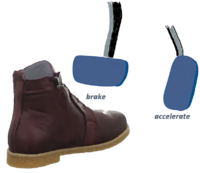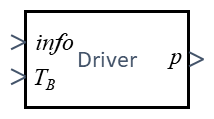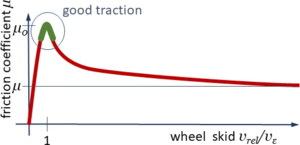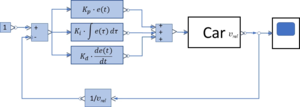Gelöste Aufgaben/JUMP/Driver Controls: Unterschied zwischen den Versionen
| Zeile 52: | Zeile 52: | ||
Thus, we set the relevant error-value to be | Thus, we set the relevant error-value to be | ||
::<math>\tilde{e} := min(e_1, e_2)</math> | ::<math>\tilde{e} := \min(e_1, e_2)</math> | ||
The controller thus adds to the state variable | The controller thus adds to the state variable | ||
Version vom 22. März 2021, 15:46 Uhr

Since we’re in a 2D-simulation environment, the driver controls only “gas” (acceleration) and breaks - no directional control needed to be taken into account.
Scope

The track poses challenges that require the driver to control the driving and breaking torque on the wheel. These track-specific challenges include
- achieving maximum acceleration, thus avoiding wheel-skid and adjusting to a slip that provides optimal traction,
- achieving maximum deceleration when breaking and therefore avoiding wheels becoming locked,
- avoiding excessive battery-temperatures and thus controlling driving torque.
Structure
The driver is tasked to control wheel slip and wheel skid via the "gas"-pedal. We differentiate between
- slip as the relative micro-velocity necessary to transmit forces in rolling contact and
- skip as unwanted excessive relative velocity resulting from poor torque-control at the wheels.
The information for this task come as "info" from the car's motion.

To avoid wheel skid and to control slip, the driver will aim to maintain a relative velocity at the wheel-contact point “C“ around the small velocity vε, thus reducing torque MW if vrel > vε and increasing MW if vrel < vε.
This is a very challenging system to be controlled because
- the velocity domain that we target is rather small and
- the characteristic for vrel > vε is degressive: the friction force decreases with relative velocity.
Model
The most common controller in technical applications is a PID-controller which are based on the proportional, integral, and derivative terms of the error-value. Our target value to control is both
- the slip-velocity vrel with set-point and
- the cruising-velocoty vc with set-point .
We define the error values e for both as
and
- .
The functions for e1 ensures that "p" increases e.g. if vrel < vε and decreases otherwise.

With controller parameters Kp, Ki, Kd we get this diagram for the controlled system.
When increasing the speed to target-value Vset, the maximum force delivered at the point of contact C governs the acceleration of the car-body. Thus, we set the relevant error-value to be
The controller thus adds to the state variable
of the system.
For the differentiator-part we would need to find
as the rate of change from the Car-Body-Model.
So the only state variable from the driver is
- .
The output "p" of the submodel is not directly a state variable, but
But since the DC/DC-converter can only take values between 0 ... 1 we define
This constraint in the value of p brings more headache to the problem, because the integrator-part Eof the controller "runs-off" if the error-value is positive for a long period of the simulation. We'll see that later.
Variables
| name | symbol | unit |
|---|---|---|
| integrator part of PID controller | E(t) | 1 |
Parameter
| name | symbol | value | unit |
|---|---|---|---|
| coefficient of proportional contribution | Kp | 1/s | |
| coefficient of integrator contribution | Ki | 100 | 1/s^2 |
| coefficient of differential contribution - not employed | Kd | 1 | |
| max. tolerated battery temperature | TB,max | 60 | °C |
| target-speed (choose very high when you want "pedal to the metal") | Vset | 10 | m/s |
next workpackage: e-motor and drive-train →
References
- Yuan, Lei; Chen, Hong; Ren, Bingtao; Zhao, Haiyan: Model predictive slip control for electric vehicle with four in-wheel motors, Proceedings of the 34th Chinese Control Conference July 28-30, 2015, Hangzhou, China, p 7895-7900
- ...